| Start of section
Production, amateur Radio amateurs Aircraft model, rocket-model Useful, entertaining |
Stealth Master
Electronics Physics Technologies Inventions |
Secrets of the cosmos
Secrets of the Earth Secrets of the Ocean Tricks Map of section |
|
| Use of the site materials is allowed subject to the link (for websites - hyperlinks) | |||
Navigation: => |
Home / Patent catalog / Catalog section / Back / |
|
INVENTION
Patent of the Russian Federation RU2053376
![]()
ELECTRIC POWER INSTALLATION
The name of the inventor: Bulkin Anatoly Efremovich; Kalashnikov Arseny Alexandrovich; Moskalenko Vladimir Valentinovich; Panov Valery Ivanovich; Panov Evgeniy Ivanovich
The name of the patent holder: Anatoly Efremovich Bulkin; Kalashnikov Arseny Alexandrovich; Moskalenko Vladimir Valentinovich; Panov Valery Ivanovich; Panov Evgeniy Ivanovich
Address for correspondence:
Date of commencement of the patent: 1993.04.09
Use: in the heat power industry to generate electricity by utilizing the heat of low-potential sources. SUMMARY OF THE INVENTION: a condensate collector 2, an electric generator 5, a turbine 6 and a feed pump are located in the housing 1. With the exhaust pipe 30, a regenerative heater 31 connected by a conduit 33 to the condenser heat exchanger 34 is connected. The heat exchanger 34 is located in the area of the heat receiver, and the steam generator 16 is located in the area of the heat source. To increase the reliability of the installation at start-up, it is equipped with a separator 20 with a float regulator of level 23, with a steam valve 21, a drain valve 24 and a bypass valve. The separator 20 prevents the moisture from entering the flowing part of the turbine, separating the moisture from the gaseous phase, and at the initial stage of the start directs the flow of the working fluid into the circumference of the turbine 6. The starting tank 10 and temporarily placed in the heat source zone allows for initial circulation of the working fluid through the steam generator And other parts of the cycle. The fan 36 makes it possible to intensify the operation of the heat exchanger 34 when the ambient air is used as a receiver.
DESCRIPTION OF THE INVENTION
The invention relates to heat power engineering and can be used to generate electrical energy by utilizing the heat of low-potential sources, natural (for example, geothermal) or on the basis of industrial wastes (for example, associated gases, heated water streams, etc.).
Electric power plants with a low-potential heat source are known, containing a housing inside which there is a condensate collector, an electric generator, a turbine and a feed pump, and a steam generator and a condenser heat exchanger located outside the casing, connected by pipelines to a turbine, condensate collector and a pump.
In these installations, no schematic and constructive measures are taken to increase the economy in conditions of small disposable heat transfer, as a result of which the utilized heat is not used efficiently. In addition, in these installations there are no means of regulation and start-up, which negatively affects reliability in both starting and normal modes. The turbine shovel is not protected from falling onto it drops of the liquid phase of the working fluid, which is especially important at start-up.
A power plant with a low-potential heat source is also known, comprising a housing in which a condensate collector is placed, interconnected by means of rotors equipped with bearings, an electric generator, a turbine with a steamer and an exhaust pipe and a feed pump with inlet and outlet nozzles, a steam generator and a heat exchanger Condenser, the first of which is placed in the zone of the source of heat, and the second one in the zone of the heat receiver (see Kulmamedov KO Development and research of the autonomous solar power plant of the steam-turbine type: the dissertation author's abstract on the competition of the scientific degree of candidate of technical sciences., Ashkhabad, Turkmen state. University, 1990, 19 pp.). And there are no measures to improve reliability, there are no means of regulation and start-up, and opportunities for increasing the efficiency of electricity production have not been sufficiently utilized.
The technical goal of the invention is to increase the reliability when starting the plant.
In order to solve the technical problem, an electric power plant with a low-pressure heat source, comprising a housing inside which a condensate collector is housed, connected to each other by means of rotors equipped with bearings, an electric generator, a turbine with a steamer and an exhaust pipe and a feed pump with inlet and outlet nozzles, a steam generator And the heat exchanger of the condenser, the first of which is placed in the zone of the heat source, and the second one in the area of the heat receiver, is additionally equipped with a regenerative heater and a separator, the input of the regenerative heater in the heating medium connected to the exhaust outlet of the turbine, the output to the condenser heat exchanger, and the heated medium To the outlet of the feed pump, and the outlet to the steam generator inlet, the separator is made in the form of a container with a float chamber, float placed therein, a drainage pipeline and a discharge line with a throttle, the separator being located inside the plant casing and connected to the pipeline between the steam generator and the turbine , And the drainage and discharge pipelines are connected to the cavity of the regenerative heater.
The plant may be further provided with a drainage cooler which is included in the drainage line between the separator and the cavity of the regenerative preheater, wherein the inlet of the drainage cooler through the heated medium is connected to the heater and the outlet to the steam generator. An additional increase in efficiency by creating a vacuum inside the housing before starting the installation can be achieved when the unit is equipped with a connection for connecting the starting vacuum pump with a check valve and a plug and a vacuum meter.
The installation can be equipped with pressure and temperature sensors installed on the pipeline between the steam generator and the separator. The separator is provided with a steam and bypass valves, the steam valve being connected on the line between the internal cavity of the separator and the steamer of the turbine and connected to the pressure sensor, and the bypass valve is connected to the discharge line and connected to a temperature sensor.
The installation can be equipped with an electric accumulator and a switch connected to the generator. It can also be equipped with a battery operated by an inverter and a switch connected to this generator. For start-up automation, the plant can be equipped with two threshold elements and an AND gate, through which the pressure and temperature sensors are connected to the switch. The plant may be provided with a starting vessel made in the form of a body made of a thermally conductive material with two inlet and one outlet pipelines and two check valves connected to the inlet pipelines, the cavity of the launch tank through the pipelines being connected to the steam generator and condensate collector and the reservoir itself being placed in the zone Source of heat. The plant can be equipped with a start-up pump, which is connected through a check valve to the line between the inlet pipe of the feed pump and the tubular heater. The starting pump can be equipped with a manual or foot drive, including a hard plate and bellows or an electric drive and battery.
The electric generator may be provided with a cooling chamber, the internal cavity of which is included in the pipeline section between the regenerative heater and the steam generator. The feed pump can be centrifugal and provided with an auger placed in its inlet nozzle and mounted on the pump rotor.
Installation using the heat of ambient air as a receiver can be equipped with a fan installed in the area of the condenser heat exchanger. When using the heat of a reservoir or water flow as a receiver, the installation can be equipped with a circulation pump, and the condenser heat exchanger is equipped with a casing connected by pipelines to a circulation pump whose inlet branch is immersed under the water level.
The plant can be equipped with additional pipelines that are connected to the pipeline between the regenerative heater and the steam generator and to the bearings of the rotors of the turbine and electric generator.
The installation can be equipped with a speed sensor, a control valve with a drive and a feedback sensor, the speed sensor can be designed as a measuring pump, and the valve drive in the form of a hydromechanical amplifier, which can be equipped with an isodromic device. The drive of the control valve can be made in the form of an electromechanical amplifier with a converter that can be connected to the output of an electric generator or to an electric speed sensor made by an electric sensor. To increase the reliability at start-up, the control valve can be equipped with a heating chamber, the cavity of which is included in the pipeline section between the steam generator and the separator.
The electric power plant is equipped with a regenerative heater, the input of which is connected to the exhaust pipe of the turbine through the heating medium, the output to the condenser heat exchanger, and, through the heated medium, the input is connected to the outlet of the feed pump, and the outlet to the steam generator inlet, and a separator made in the form of a tank with a float chamber , Placed in it by a float, a drainage pipeline and a discharge line with a throttle, the separator being located inside the plant casing and connected to the pipeline between the steam generator and the steam turbine, and the drainage and discharge pipelines are connected to the cavity of the regenerative preheater, together with the known set of characteristics , Which has significant differences compared to the set of features of known installations and provides a solution to the technical problem. These constructive design of the regenerative heater and separator and their inclusion in the installation scheme increases the economy, prevents the drops of the liquid phase of the working fluid from the steam generator to the turbine blades and thereby increases the reliability at the start-up of the plant when the temperature of the working fluid in the steam generator is still insufficient to form a purely superheated couple. The characteristics given in the additional clauses of the formula ensure that these effects are achieved.

In Fig. 1 shows a schematic structural diagram of the proposed power plant with a low-potential heat source; In Fig. 2 shows the construction of a separator; In Fig. 3 and 4 are diagrams of connecting to the battery, respectively, the generator of direct and alternating current to ensure the possibility of the generator in the mode of the starting engine; In Fig. 5 shows the connection diagram of the starting pump; In Fig. 6 shows the design of the starting pump with manual drive; In Fig. 7 design of a feed pump with a screw in the inlet pipe; In Fig. 8 shows the connection diagram of the circulation pump; In Fig. 9 shows the design of a hydromechanical amplifier with an isodromic device; In Fig. 10 connection diagram of the electromechanical amplifier; In Fig. 11 shows the design of a control valve with a heating chamber.
The electric power plant with a low-potential heat source contains a body 1, in the lower part of which there is a condensate collector 2 with a liquid phase of the working fluid. The working medium should be of low boiling point (for example, alcohols, aromatic hydrocarbons, etc.). The reducer 4 is mounted on the partition 3, through which the rotors of the electric generator 5, the turbine 6 and the feed pump 7 are connected together (it is possible and in some cases expedient to directly connect the generator, turbine and pump rotors without a reducer). The inlet pipe 8 of the feed pump 7 is equipped with a filter and placed under the liquid level in the condensate collector 2. The rotor of the feed pump 7 is connected to the rotor of the measuring pump 9, which is a speed sensor.
The starting tank 10, the body of which is made of heat-conducting material, is placed during the start-up in the zone of the heat source. By the inlet conduits 11 and 12 through the check valves 13, the reservoir 10 is connected to the conduit 14 and to the condensate collector 2. With the outlet conduit 15, the reservoir 10 is connected to the steam generator 16 placed in the heat source zone. To the output of the steam generator 16, a conduit 17 of the steam supply path 17 is connected to the steamer 18 of the turbine 6. In this path, a temperature sensor 19, a separator 20, a separator steam valve 21 and a control valve 22 are connected. The separator 20 is provided with a level float controller 23 connected to a drain valve 24, Which is installed in the drain line 25. The separator is provided with a discharge line 26 with a throttle 27 and a bypass valve 28 connected to a temperature sensor 19. The steam valve 21 is connected to a pressure sensor 29.
With the exhaust pipe 30 of the turbine 6, the cavity of the regenerative heater 31 is connected. In this cavity a tubular heater 32 is disposed and a discharge conduit 26 is connected to this cavity. By means of the conduit 33, the cavity of the regenerative heater 31 is connected to the condenser heat exchanger 34, and by the conduit 35 the heat exchanger 34 Is connected to the condensate collector 2. When using the heat of the ambient air in the area of the heat exchanger 34, an electric fan 36 connected via a cable 37, a switch 38 and a fuse 39 to the line 40 at the output of the electric generator 5 can be installed. Cable 41 for supplying the external consumer with electricity generated by this installation.
The outlet branch pipe 42 of the feed pump 7 is connected to the tubular heater 32 by a conduit 43. The outlet of the tubular heater 32 is connected by a conduit 44 to a drainage cooler 45 whose cavity is connected to the drain line 25 and to the exhaust port 30 of the turbine. The drainage cooler 45 is connected to the cooling chamber 47, which is provided in the housing of the electric generator 5, and then through the conduit 14 to the steam generator 16 through the conduit 46. By additional pipelines 48, 49 and 50, the bearings of the turbine 6 and the generator 5 are connected to a conduit 46 connecting the regenerative heater And a steam generator. This ensures lubrication of bearings with the working body of the installation. For this purpose, it is also possible to connect an additional pipeline 48 to the pipeline 43, i.e. At the site of supply of the working fluid to the regenerative heater (this is not shown conditionally in Fig. Here the working medium is less heated and can therefore ensure not only lubrication, but also cooling of the bearings.
The control valve 22 installed before the steamer of the turbine 6 is provided with a drive 51. If the speed sensor is a measuring pump 9, as shown in FIG. 1, the actuator 51 can be made in the form of a hydromechanical amplifier, the inlet of the measuring pump 9 is connected to a low-pressure cavity of the working fluid, for example directly to the condensate collector 2, and the actuator 51 is connected to the pump outlet 9 (and its inlet branch) by conduits 52.
The body of the plant is provided with a cover 53 sealing the cavity inside the housing. Connector 54 is connected to this cavity for connection of the starting vacuum pump (the vacuum pump in Fig. 1 is not shown). The socket 54 is provided with a check valve 55 and a plug 56. A vacuum meter 57 is provided to control the vacuum in the cavity within the housing.
 |
The separator of the plant (see Figure 2) comprises a separator housing 58, a float chamber housing 59, and a housing 60 of a temperature sensor 19 that can be provided with thermal insulation 61. Inside the housing 58, a coiled tubing 62 with drain holes 63 is disposed, A cavity within the housing 60 of the temperature sensor to which the pipeline 17 is connected from the steam generator. The cavity inside the separator casing 58 is connected to the float chamber directly and to the conduit 65 to the steam turbine through the steam valve 21. The floating float 66 of the float level control is placed in the float chamber. Through the lever 67, the float is kinematically connected to a drain valve 24 housed in the body 68. The steam valve 21 is connected via a rod 69 to a pressure regulator formed by a bellows 70 and a spring 71. The spring 71 is supported at its ends by a stem plate 69 and a cap 72, Bellows 70 are fixed to the valve 21 and to the lid 73 provided with a stop valve 74. The inner cavity of the bellows 70 is connected by a channel 75 to the cavity 76 behind the bypass valve 28. This valve is connected to a temperature sensor 19 made in the form of a rod disposed inside the housing 60. The rod material has a coefficient of thermal expansion greater than that of the material of the housing 60. One end of the rod is fixedly fixed to the housing 60 by means of a partition 77 and a cap nut 78. To start the installation, it is necessary to circulate the working fluid through the steam generator, turbine and condenser. One possibility is to use for this purpose a feed pump 7 (see Figure 1), the drive of which in the starting phase is provided by an electric generator 5 operating in the starting motor mode. |
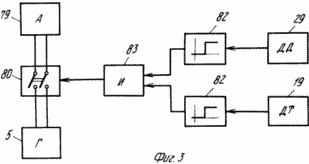 |
In the case of using an electric DC generator in the installation, it is powered by the electric battery 79 (see Figure 3) connected to the generator 5 via the switch 80. In the case of using an electric alternator (for example, a three-phase synchronous generator with excitation From a permanent magnet) a controlled inverter 81 is connected to the circuit between the accumulator 79 and the switch 80 (see Figure 4), at the output of which an alternating current is generated with a frequency gradually increasing to the nominal value during the start-up process. Automatic matching of the generator operation time in the engine mode with the moment when the working medium necessary for normal operation is reached is provided by the use of a temperature sensor 19 and a pressure sensor 29. As shown in Fig. 3 and 4, these sensors are connected via the threshold elements 82 to the inputs of the AND gate 83, the output of which is connected to the switch 80. |
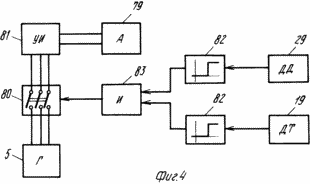 |
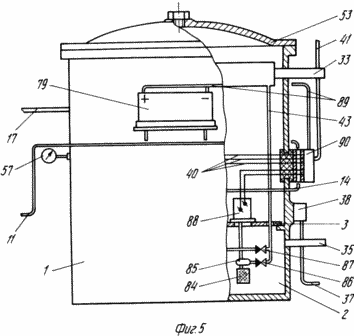 |
It is also possible to start the installation with a special starting pump. The inlet pipe 84 with the start pump filter 85 (see Figure 5) is connected to the condensate collector 2 and the outlet pipe is connected through a check valve 86 to the pipeline 43. The same pipe connecting the feed pump outlet pipe and the tubular heater is turned on (to the point Connection of a non-return valve 86) a non-return valve 87. The start pump 85 can be electrically actuated 88. A battery 79 can be used to power this drive, located outside the installation housing 1. By line 89, the battery 79 is connected to the switching and converting unit 90. This block includes a fuse 39 (see Figure 1), a switch 80 (see Figures 3 and 4), a controlled inverter 81, and a rectifier (if necessary provide DC power to the consumers from the installation with an alternator) and others Elements of the circuitry of the installation, for example, means of monitoring and signaling. Similar to the electric generator 5 (see Figure 1), the unit 90 may be provided with a cooling chamber included in the pipeline section between the regenerative heater and the steam generator. An electrical actuator 88 of the starting pump is connected to the unit 90, and a power supply cable 37 to the fan drive (see Figure 1) and a cable 41 for supplying an external consumer. |
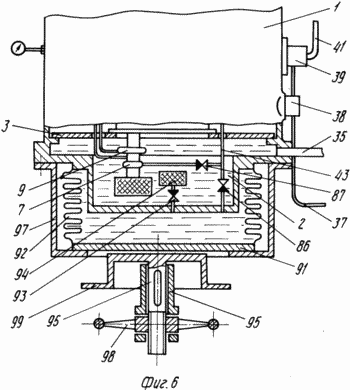 |
The starting pump can be equipped with a manual or foot drive. The manual drive can be made (see Figure 6) in the form of a fixed rigid plate 91 and a bellows 92 fixed to the bottom of the body 1 where the condensate collector 2 is located. The inner cavity of the bellows 92 is communicated with the condensate collector 2 by means of an additional check valve 93 and the filter 94. The hand drive threaded rod 95 is mounted in the fixed guide 96 connected to the cap cap 97 (this relationship is not shown in Fig. The stem 95 is provided with a hand wheel 98 and a plate 99 kinematically connected to the plate 91. |
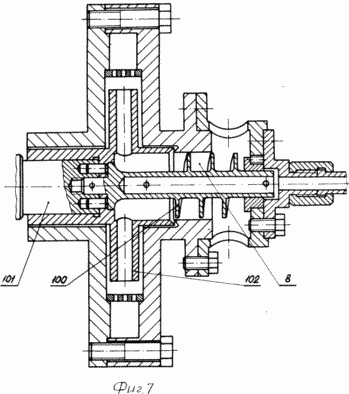 |
The cavity inside the housing 1 (see Figure 1) is under vacuum. In order to reduce the threat of cavitation of the feed pump 7 under these conditions, its inlet pipe is placed under the liquid level in the condensate collector 2. To further enhance the reliability of the protection against cavitation, a screw 100 is mounted in the inlet pipe 8 (see Figure 7), mounted on the pump rotor Shaft 101 and impeller 102. Therefore, the screw 100 rotates together with the impeller 102, creating a support on the suction side of the wheel. |
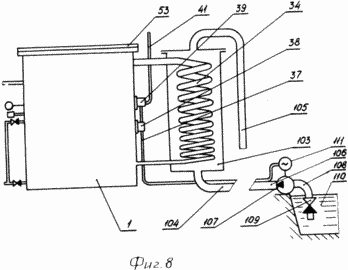 |
As a heat receiver, not only the atmospheric air can be used, as shown in FIG. 1, but also a pond or water flow (see Figure 8). In this case, the condenser heat exchanger 34 is provided with a casing 103 having a supply conduit 104 and a discharge conduit 105. The outlet conduit 106 of the circulation pump 107 is connected to the supply conduit 104, and the inlet pipe 108 of this pump is provided with a check valve 109 and is immersed in a water level in the reservoir 110 Artificial or natural) or in a stream of water (in a stream, river, canal, etc.). The pump 107 is electrically driven 111, which is powered by the output of the electrical generator of the plant through a switch 38 and a cable 37. |
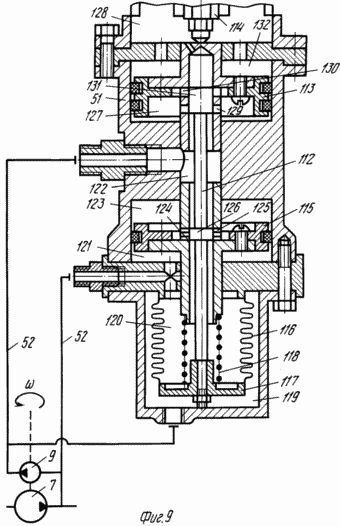 |
As shown in Fig. 1, a control valve 22 installed before the steamer 18 of the turbine 6 and provided with a drive 51 to which a speed sensor is connected kinematically connected to the rotor of the turbine 6 is provided for automatic adjustment of the operation mode of the plant. When the measuring motor 9 is used as the speed sensor of the measuring pump 9, the actuator 51 The hydromechanical amplifier can be made in accordance with FIG. 9. A slide valve 112, a control valve piston 113 is shown in the actuator body (the stem 114 of this valve is shown in FIG. 9), an isodromic device piston 115, a bellows 116 attached to the body and a plate 117 connected to the spool 112 and a spring 118 The inlet and outlet connections of the measuring pump 9 are connected by conduits 52 to the chambers 119, 120, 121, 122. The chamber 120 inside the bellows 116 and the chamber 121 below the piston 115 are constantly communicated with each other. The chamber 123 above this piston can be communicated with the chamber 120 or the chamber 122, respectively, through the windows 124 or the windows 125, depending on the displacement of the piston 126 of the spool 112 relative to the piston 115, respectively, upward or downward. Similarly, the cavity 127 under the piston 113 can be communicated with the chamber 122 or with the drain cavity 128 respectively through the windows 129 or the windows 130 when the piston 131 of the spool 112 is moved relative to the piston 113, respectively, upward or downward. The cavity 132 above the piston 112 communicates with the drain cavity 128 continuously. |
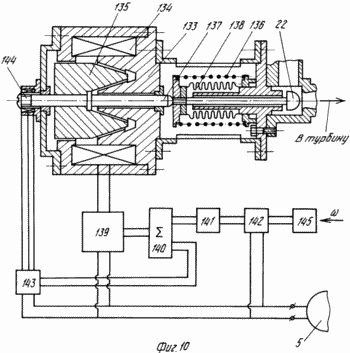 |
The actuator 51 of the control valve may also be provided in the form of an electromechanical amplifier. In Fig. 10 shows one possible embodiment of the electromechanical amplifier 4 in the form of a traction electromagnet formed by a magnetic circuit 133, a coil 134 and an armature 135, and an opposing spring 136. The electromagnet shaft 137 cooperates with a control valve 22. The bellows 138 is designed to prevent leakage of a pressurized working fluid In the valve chamber 22, into the cavity inside the housing of the installation. The coil 134 is connected to a control unit 139 to which an adder 140 is connected to an input. One of the inputs of the adder 140 is connected via a driver 141 to the output of the converter 142, and the second input of the adder is connected via a driver 143 to a feedback sensor 144 interacting with the rod 137. A specially provided electric speed sensor 145, kinematically connected to the turbine rotor, can be connected to the input of the converter 142. In this case, the electric generator 5 only provides power to the unit 139 of the converter 142, the driver 143 and other circuit elements. It is also possible to use the generator 5 and as a speed sensor for the rotors of the installation, since the current at the output of the generator contains information about the change in the speed of rotation in the form of voltage deviation or and frequency of current (in the alternator). In this case, the use of a special speed sensor becomes unnecessary. |
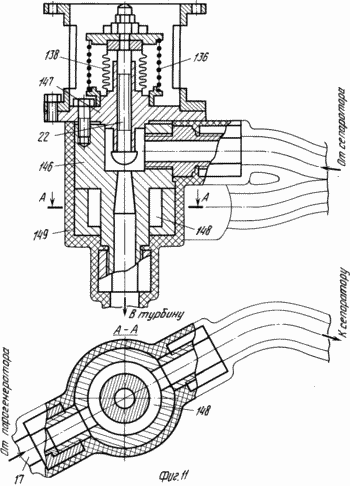 |
The control valve 22 may be provided with a heating chamber, as shown in FIG. 11. In the valve body 146 provided with the cover 147, a heating chamber 148 is included in the cut-out of the pipe 17 between the steam generator and the separator. This ensures that the valve body 146 is warmed up at the very beginning of the start-up, when the heated working body of the plant comes from the steam generator to the separator. To increase the efficiency of heating, the housing 146 can be covered with heat insulation 149. Preheating reduces the intensity of thermal stresses during the start-up, removes the risk of moisture entering the flowing part of the turbine and thereby improves the reliability of the installation. This electric power plant works as follows. Under normal operating conditions, steam is generated in the steam generator 16 (see Figure 1) placed in the area of the heat source (for example, geothermal or using the heat of combustion of associated gas or waste of any production). Through the pipeline 17, steam through the separator 20 and its vapor valve 21 flows to the control valve 22 and then through the steamer 18 to the turbine 6. The rotor of the turbine 6 rotates the rotor of the generator 5, the output of which generates a constant or alternating current (depending on the type of generator) Which is fed through line 40 to fuse 39 and then via cable 41 to an external consumer (with the necessary transformations of the current type and its voltage). |
The exhausted steam in the turbine 6 passes through the exhaust pipe 30 into the cavity of the regenerative heater 31 where it gives off a part of the heat to the working fluid pumped through the tubular heater 32. Then, the steam through the pipeline 33 enters the heat exchanger 34 located in the area of the heat receiver. If atmospheric air is used as a heat receiver, it is possible to intensify the operation of the heat exchanger 34 by means of a fan 36. The electric drive of this fan is powered by an electric generator 5 through a switch 38 and a cable 37.
As a receiver of heat, you can use either a reservoir 110 or a stream of water in a stream, river, etc. (See Figure 8). In this case, the heat exchanger is enclosed in a casing 103 where cooling water from the reservoir 110 is supplied by the circulation pump 107. The electric actuator 111 of the pump 107 receives power from the generator in a similar manner through the switch 38 and the cable 37. The non-return valve 109 prevents the cavity of the casing 103 from being emptied in the event of pump shutdown 107.
In the heat exchanger 34, the working medium of the cycle condenses and flows into the condensate collector 2 through a line 35 (see Figure 1). A feed inlet 8 of the feed pump 7 is placed under the liquid level in the condensate collector 2. The rotor of this pump is kinematically connected to the rotor of the turbine 6 and rotates together with Supplying the liquid working medium through the conduit 43 to the tubular heater 32. After the heater 32, the working fluid enters the drain cooler 45 drained from the separator 20. Then, through the conduit 46, liquid enters the cooling chamber 47, where it is further heated by the heat released in the electric Generator 5. Additional pipelines 48, 49, 59 are connected to the pipeline 46, through which the working medium is fed to the lubrication of the bearings of the rotors of the turbine 6 and the generator 5. After the bearings, this part of the working fluid merges again into the condensate collector 2.
Through the conduit 14, the working fluid is fed through one of the check valves 13 to the steam generator 16 for reheating and evaporation.
For efficient operation of the installation, the cavity inside the housing 1, where the turbine 6 is located, the condensate collector 2 and most other units, must be under vacuum, corresponding to the saturation pressure of the working fluid at the temperature of the cooling medium. Therefore, the cavity inside the casing 1 is sealed with a lid 53, and all outlets of pipelines and cables must be sealed. Before starting work, air must be removed from the cavity. For this purpose, a nozzle 54 is provided, to which a starting vacuum pump is connected. The evacuation process is controlled by a vacuum meter 57. After the air is exhausted, the vacuum pump is disconnected and the cavity inside the housing 1 is locked by a check valve 55. An additional density is provided by the plug 56.
In order for the installation to work, it is necessary to raise the parameters of the working fluid to a level corresponding to the superheated steam, without particles of moisture, when a safe operation of the turbine is possible. Up to this point, the turbine 6 does not rotate the feed pump 7 and, therefore, the supply of the working fluid to the steam generator 16 must be provided by other means. In Fig. 1, one of the possible solutions is shown using the start-up tank 10. This reservoir is first filled with a working fluid through a line 12 through a check valve 13, lowering the reservoir below the liquid level in the condensate collector 2, and then placed for the start-up time (for this, the pipes 11, 12 and 15 Should be made flexible) in the area of the source of heat. The body of the reservoir 10 is made of a heat conducting material and the working body in the reservoir starts to heat and then evaporates through the steam generator 16 to the separator 20. In this case, the check valves 13 do not allow the flow of the working fluid into the condensate collector 2 and the conduit 14. The working fluid reservoir in the reservoir Is selected based on the expected start time.
The circulation of the working medium during the start-up phase can also be ensured with the aid of a feed pump 7 if for this period an electric generator 5 is used in the engine mode. For this, according to FIG. 3 and 4, the generator is connected to the electric accumulator 79 via a switch 80. The DC generator can be connected to the battery as shown in FIG. 3, if the voltage at the output of the battery is compatible with the generator parameters, or through additional converters. To use the alternator in motor mode, a controlled inverter 81 (see Figure 8) is required, the output frequency of the alternating current increases to provide an increase in the speed of the unit at a given rate.
The end of work in the engine mode and the transition of the generator 5 to the normal mode of generating electric current are possible after reaching the required steam parameters before the turbine, including it in operation, including for driving the feed pump. The onset of this moment can be monitored by the signals of the temperature sensor 19 and the pressure sensor 29. When the temperature and vapor pressure reach the corresponding threshold values set by the threshold elements 82, the AND gate 83 is triggered, which causes the switch 80 to automatically switch off the battery 79 from the generator 5 (see Figures 3 and 4).
The initial circulation of the working fluid can also be created by a special starting pump. If this pump is electrically driven 88, as shown in FIG. 5, when the installation is started, the battery 79 is used, to which the drive 88 is connected via a switching and converting unit 90. The check valves 86 and 87 prevent draining of the working fluid through the start pump 85 or the feed pump, respectively, when the feed pump or the start pump is operated, and supply the working fluid only to the pipeline 43. Disconnection of the start pump 85 after the turbine and the feed pump is operational can be automated by sensors Temperature and pressure of the vapor, similar to that shown in FIG. 3 and 4.
In block 90 (see Figure 5), a converter can be provided for automatically charging the battery 79 from the installation generator during normal operation.
If the start-up pump is provided with a manual drive as shown in FIG. 6, the initial circulation of the working fluid at the start is provided by acting on the hand wheel 98. As a result, the threaded rod 95 and the plate 99 begin to rise acting on the plate 91. This causes the liquid to be displaced from the cavity within the bellows 92 through the check valve 86 to the line 43 supplying the working Body in the steam generator. As in the previous case, the check valve 87 prevents the discharge of the working fluid through the feed pump 7 at start-up. The initial filling of the cavity inside the bellows 92 is carried out from the condensate collector 2 through the check valve 93 and the filter 94. The restriction cover 97 prevents the bellows 92 from being too deformed.
To ensure reliable operation of the turbine and the installation as a whole, it is necessary to minimize the possibility of liquid entering the working medium phase into the flowing part of the turbine. This possibility is especially great at start-up, when the temperature and pressure of the working fluid are still noticeably lower than the normal level. At this stage, the separator provided in this plant not only separates the liquid phase from the gaseous phase, but also directs the working fluid into the turbine bypass. As shown in Fig. 2, the working fluid from the steam generator enters the separator via line 17. In the initial starting period, the bypass valve 28 is fully open, and the steam valve 21 and drain valve 24 are completely closed. The working medium is mainly guided through the valve 28, the cavity 76, the throttle 27 and the discharge line 26 into the cavity of the regenerative preheater and further into the condenser heat exchanger, bypassing the turbine. Some part of the working fluid also flows through the channel 64 into the spiral pipeline 62, where, due to the rotational motion of the flow, the liquid phase is intensively separated and flows through the drainage holes 63 into the float chamber. As the level of the liquid in the chamber rises, the float 66 begins to open the drain valve 24 and excess liquid is sent through the drain line 25 to the drain cooler and then through the cavity of the regenerative preheater to the condenser heat exchanger.
As the pressure builds up behind the steam generator and inside the casing of the separator 58, the force difference acting on the large surface of the steam valve 21 from the cavity side inside the casing 58 and to the smaller surface of the same valve from the cavity side inside the bellows 70 increases. When said force difference becomes greater than c Side of the spring 71, the steam valve 21 begins to rise, opening the gaseous phase to the conduit 65 and further to the steam turbine. As the temperature of the working fluid behind the steam generator rises, the temperature sensor 19, which is the stem of the bypass valve 28, lengthens longer than the housing 60, since it is made of a material with a large coefficient of thermal expansion than the housing material. Therefore, the bypass valve 28 begins to gradually close, and at a temperature slightly below the nominal, completely blocks the flow of the working fluid into the cavity of the regenerative preheater. As a result, all flow from the steam generator is directed through the channel 64 into the cavity within the separator casing 58. The steam valve 21 is thus fully open, since after closing the valve 28, the pressure inside the cavity of the bellows 70 drops abruptly, approaching the pressure behind the turbine. Pipeline 65 and turbine steam are supplied with moisture vapor separated from moisture and moisture is drained through drain valve 24. As the steam temperature rises above the nominal value, further extension of the rod of temperature sensor 19 causes its operation to buckle.
Automatic maintenance of the rotor speed of the turbine and generator rotors, and therefore, to a greater extent, the stabilization of the parameters of the electric current generated by this installation is carried out by a control valve installed on the steam supply to the turbine. The control of this valve on the signal of the hydrodynamic speed sensor of the measuring pump 9 is performed by a hydromechanical amplifier (see Figure 9). For example, as the rotor speed of the turbine and pumps, including the pump 9, increases, the pressure in the chamber 119 outside the bellows increases, and the spool 112, overcoming the force of the spring 118, moves upward. Through the windows 129 opened by the piston 131, the working body from the chamber 122 from the pump enters the cavity 127 and the piston 113 and shifts upward, moving the regulating valve rod 114 towards its closure. In addition, when the spool 112 moves upwardly its piston 126 opens the windows 124, the chamber 123 communicates through the chamber 120 with the suction line of the measuring pump 9 and the pressure over the piston 115 of the isodromic device decreases. The piston 115 starts to move upward, this movement being slower than the movement of the piston 113, since the windows 124 (and 125) are provided with a reduced cross-section. The upward movement of the piston 115 leads to a decrease in the spring 118 tension, to a further upward movement of the spool 112 and the piston 113, and to an additional closure of the turbine control valve. This achieves the isodromic effect of the hydromechanical amplifier. The dynamic and residual statism of such isodromic regulation is determined by the ratio of the stiffness of the bellows 116 and the spring 118.
When the rotational speed is deflected towards its decrease, the action of the elements of the hydromechanical amplifier takes place in a similar manner, but in the opposite direction.
If the drive of the control valve is made in the form of an electromechanical amplifier, then the speed sensor is advisable and have an electrical (see Figure 10). A special sensor 145 or electric generator 5 provides a speed change signal to the input of the converter 142 where the frequency or voltage deviation is converted to a signal at the input of the driver 141. Through the adder 140, the speed change signal is applied to the control unit 139, In the coil 134 and the force acting on the armature 135 and counterbalanced by the spring 136. As a result, the stem 137 biases the control valve 22 so as to limit the variation in the rotational speed of the turbine rotors and associated aggregates. Valve motion feedback is provided by the sensor signal 144 supplied to the input of the adder 140. In the control unit 139, more complex control laws can be implemented, if necessary, including effects on the derivative and the deviation integral.
CLAIM
1. ELECTRIC POWER PLANT with a low-potential heat source, comprising a housing that houses a condensate collector connected to each other by means of rotors equipped with bearings, an electric generator, a turbine with a steamer and an exhaust pipe and a feed pump with inlet and outlet nozzles, a steam generator and a heat exchanger for the condenser , The first of which is placed in the zone of the heat source, and the second one is located in the zone of the heat receiver, characterized in that it is additionally equipped with a regenerative heater, separator, the input of the regenerative heater in the heating medium is connected to the turbine exhaust port, the output to the condenser heat exchanger, and On the heated medium, the inlet is connected to the outlet of the feed pump, and the output is to the input of the steam generator; the separator is made in the form of a container with a float chamber, a float placed in it, a drainage valve kinematically connected with a float, a drainage pipeline and a discharge line with a throttle; The separator is housed in a casing and is included in the pipeline between the steam generator and the steam turbine of the turbine, and the drainage and discharge pipelines are connected to the cavity of the regenerative heater.
2. Installation according to claim 1, characterized in that a drainage cooler is connected to the drainage line between the separator and the cavity of the regenerative heater, the input of which is connected to the regenerative heater through the heated medium, and the output to the steam generator.
3. An installation according to claim 1, characterized in that it is provided with a connection for connecting a starting vacuum pump with a check valve and a plug and a vacuum gauge, with a fitting and a vacuum gauge installed outside the housing and connected to its cavity.
4. Installation according to claim 1, characterized in that it is provided with pressure and temperature sensors installed on the pipeline between the steam generator and the separator.
5. A plant according to claim 1, characterized in that the separator is provided with a steam and bypass valves, the steam valve being connected between the internal cavity of the separator and the steam turbine and connected to the pressure sensor, and the bypass valve is connected to the discharge line and connected to a temperature sensor.
6. The plant according to claim 1, characterized in that it is provided with an electric accumulator and a switch which are connected in series to an electric generator.
7. The plant of claim 6, wherein a controllable inverter and a switch connected to the output of the inverter and an electric generator are connected to the electric battery.
8. The plant of claim 6 and 7, characterized in that it is provided with two threshold elements and an AND gate, the pressure and temperature sensors being connected through the threshold elements to the inputs of the AND gate, the output of the second being connected to the switch.
9. An installation according to claims 1 to 5, characterized in that it is provided with a launch tank made in the form of a body made of a heat conducting material with two inlet and one outlet pipelines and two check valves connected to the inlet pipelines, the first inlet duct, the cavity The start tank and the outlet pipeline are connected in series to the pipeline section between the regenerative heater and the steam generator, the second inlet pipeline is connected to the condensate collector and the launch tank is placed in the heat source zone.
10. An installation according to claims 1-5, characterized in that it is provided with a starting pump with inlet and outlet nozzles and two check valves, the inlet port of the start-up pump connected to the condensate collector, the outlet pipe to the pipeline between the outlet pipe of the feed pump and the regenerative heater On the heated medium, and the check valves are installed in series with the inlet ports of the feed and start-up pumps.
11. An installation according to claim 10, characterized in that the starting pump is provided with a manual or a foot drive.
12. An installation according to claim 11, characterized in that the start-up pump is in the form of a rigid plate and bellows, one end of which is fixed to the plate and the second to the lower part of the housing, the drive is kinematically connected to the plate, and one of the check valves is connected to Internal cavity bellows.
13. An installation according to claim 10, characterized in that the starting pump is provided with an electric drive and a battery.
14. An installation according to claim 1, characterized in that the electric generator is provided with a cooling chamber which is formed in its housing and whose internal cavity is included in the pipeline cut between the regenerative heater and the steam generator.
15. Apparatus according to claims 1 and 10, characterized in that the feeding pump is centrifugal and is equipped with a screw placed in its inlet branch and fixed on the pump rotor.
16. An installation according to claim 1, characterized in that it is provided with an electrically driven fan, wherein the fan is mounted in the region of the condenser heat exchanger and its electric drive is connected to the output of the electric generator.
17. An installation according to claim 1, characterized in that it is provided with an electrically driven circulating pump, with inlet and outlet nozzles and a check valve, and the condenser heat exchanger is provided with a casing with a supply and discharge conduit, the supply conduit being connected to the outlet of the circulation pump, The check valve is installed in the inlet pipe, which is immersed under the water level, and the electric drive of the circulation pump is connected to the output of the electric generator.
18. An installation according to claim 1, characterized in that it is provided with additional pipelines connected to the pipeline between the regenerative heater and the steam generator and to the bearings of the rotors of the turbine and electric generator.
19. The plant of claim 1, characterized in that it is provided with a speed sensor and a control valve with a drive and a feedback sensor, the control valve being installed in the pipeline before the turbine is vaporized, and the speed sensor is kinematically coupled to the turbine rotor and connected to the drive Control valve.
20. An installation according to claim 19, characterized in that the speed sensor is a measuring pump with inlet and outlet nozzles, and the control valve drive is in the form of a hydromechanical amplifier, the inlet pipe of the measuring pump being connected to the low-pressure cavity of the working fluid, and Outlet nozzle - with hydromechanical amplifier.
21. The apparatus of claim 20, wherein the hydromechanical amplifier is provided with an isodromic device.
22. The plant of claim 19, wherein the control valve drive is in the form of an electromechanical amplifier provided with an adder connected to its input and a converter connected by its output to the first input of the adder, the second input of which is connected to a feedback sensor.
23. The plant of claim 22, wherein the converter input is connected to the output of the electric generator.
24. The plant of claim 20, wherein the speed sensor is electrically and the converter input is connected to the output of this sensor.
25. The plant according to claims 19 to 24, characterized in that the control valve is provided with a heating chamber formed in the outer part of the valve body and whose cavity is included in the pipeline cut between the steam generator and the separator.
print version
Publication date 16.02.2007gg




Comments
Commenting on, remember that the content and tone of your message can hurt the feelings of real people, show respect and tolerance to your interlocutors even if you do not share their opinion, your behavior in the conditions of freedom of expression and anonymity provided by the Internet, changes Not only virtual, but also the real world. All comments are hidden from the index, spam is controlled.